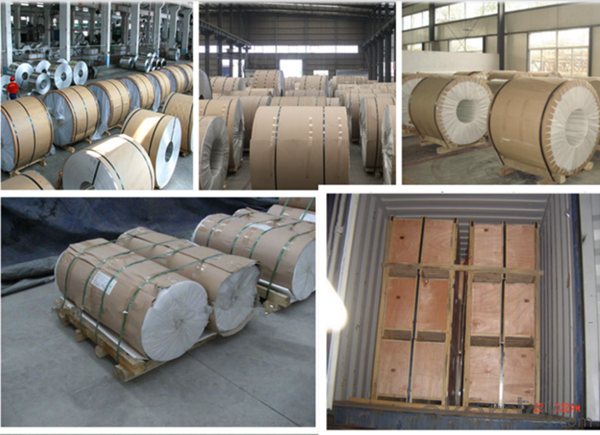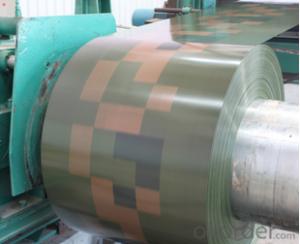SPHC SS400 HR Hot rolled Steel Coil Mill Directly Supply
- Loading Port:
- Tianjin
- Payment Terms:
- TT OR LC
- Min Order Qty:
- 50 m.t.
- Supply Capability:
- 1104 m.t./month
OKorder Service Pledge
OKorder Financial Service
You Might Also Like
Specification
Hot rolling is a mill process which involves rolling the steel at a high temperature (typically at a temperature
over 1700° F), which is above the steel’s recrystallization temperature. When steel is above the recrystallization
temperature, it can be shaped and formed easily, and the steel can be made in much larger sizes. Hot rolled steel
is typically cheaper than cold rolled steel due to the fact that it is often manufactured without any delays in the
process, and therefore the reheating of the steel is not required (as it is with cold rolled). When the steel cools
off it will shrink slightly thus giving less control on the size and shape of the finished product when compared to
cold rolled.
Uses: Hot rolled products like hot rolled steel bars are used in the welding and construction trades to make
railroad tracks and I-beams, for example. Hot rolled steel is used in situations where precise shapes and
tolerances are not required
Standard and Grade :
Hot rolled steel coils | ||||
JIS | ASTM | SAE | EN | |
Commercial quality | G3131 SPHC | A569 A635 A659 A1011 CS Type A,B,C | 1006~1025 |
10111 DD11 |
Drawing quality | G3131 SPHD | 1006~1010 | 10111 DD12 | |
Deep drawing quality | G3131 SPHE | A622 A1011 DS Type A,B | 1006~1010 | 10111 DD13 DD14 |
General structure (T.S.<490N/MM2) | G3101 SS330 SS440 G3106 SM400A G3132 SPHT1 SPTT2 SPHT3 | A36 A283 GR.C A570 GR.30~40 A1001 SS GR.30~40 |
1010~1025 | |
General structure (T.S.≥490N/MM2) | G3101 SS490 G3106 SM490A SM490YA | A570 GR.45~50 A607 GR.45~70 A1011 SS GR.45,50 |
J1392 050X | |
|
|
Application :
Automobile Industry, electrical appliance, machinery manufacturing, container manufacturing, shipbuilding,
bridge, pipeline, and receive high acclaim from our customers for its excellent quality.
Packing:
Packaging Detail | The packing of coil consists of anti-damp paper ,PVC film ,hardboard paper , steel box , strapped with steel strips, fitted with locks and edge protectors and guarantees the optimal condition of the delivered goods. Each coil can be additionally fitted with wooden/steel skids(eye of the side) or wooden pallets(eye of the sky) |
Delivery Time | within 30 days of receipt of LC original or prepayment |


Our Services
MOQ | FCL, 25 metric tons per 20GP, can be assorted with different sizes. |
LCL for trial order is acceptable. | |
Price Term | EX-WORK, FOB China Port, CNF, CIF |
Payment | T/T, 30% advanced payment before production and balance before shipment; OR Irrevocable L/C at sight. |
Delivery Time | within 30 days of receipt of LC original or prepayment |
FAQ:
1. Can you offer OEM to me? What about MOQ?
Of course, we are a professional with OEM manufacturer for 9 years. the MOQ can be 50 ton/ order..
2. How to guarantee the quality of the products?
We have established the international advanced quality management system,every link from raw
material to final product we have strict quality test;We resolutely put an end to unqualified products
flowing into the market. At the same time, we will provide necessary follow-up service assurance.
3. How long can we receive the product after purchase?
Usually within thirty working days after receiving buyer’s advance payment or LC. We will arrange the
factory manufacturing as soon as possible. The cargo readiness usually takes 15-25 days, but the
shipment will depend on the vessel situation.
4.Q: What is your terms of payment ?
We prefer LC at sight and 30%T.T in advance ,balance after the copy of B/L
- Q: How are steel coils used in the production of steel fasteners?
- Steel coils are used in the production of steel fasteners by being processed into flat strips or wires, which are then cut, shaped, and threaded to create various types of fasteners such as screws, bolts, and nuts. The coils provide a continuous supply of steel material that is easily manipulable and can be efficiently transformed into the desired shape and size for fastener production.
- Q: How do steel coils compare to other materials, such as aluminum or copper?
- Steel coils have several advantages over other materials like aluminum or copper. Firstly, steel is generally stronger and more durable, making it suitable for heavy-duty applications. Steel coils also have a higher melting point, which means they can withstand higher temperatures without losing their structural integrity. Additionally, steel is typically more cost-effective and widely available compared to aluminum or copper. However, it's important to note that the choice between these materials depends on the specific requirements of the application, as aluminum and copper may offer advantages in certain scenarios such as electrical conductivity or weight reduction.
- Q: Suppose you made a sword out of diamond (just follow me here, it's only theoretical). Would it be lighter than a sword of the same size made out of steel?
- Just compare the densities. The density of diamond is about 3.5g/mL. While there are different types of steel with different densities, steel is mostly iron, so the density of iron is a good approximation. Iron has a density of 7.87g/mL. Steel is over twice as dense as diamond, so the diamond sword would be lighter.
- Q: How are steel coils used in the production of storage racks?
- Steel coils are used in the production of storage racks by being uncoiled, cut, and shaped into the required dimensions and components of the racks. These steel coils provide the necessary strength and durability to support heavy loads and ensure the stability and longevity of the storage racks.
- Q: What are the common coil widths and thickness combinations available for steel coils?
- The steel coils available in the market come in various combinations of coil widths and thicknesses, depending on the specific requirements and industry standards. While there are some standard sizes commonly found, there is also the option for custom widths to cater to specific project needs. In terms of coil widths, the market offers a range of standard sizes, with the most common ones falling between 600mm and 2000mm. These widths find extensive use in industries like automotive, construction, and manufacturing. Nevertheless, it is possible to obtain custom widths tailored to the requirements of a particular project. Regarding thickness combinations, steel coils are typically available in a variety of thicknesses. The most widely used thicknesses for steel coils fall within the range of 0.4mm to 3mm. However, it is also possible to obtain thicker or thinner options depending on the specific application. It is important to bear in mind that these standard sizes and thickness combinations may vary depending on factors such as the specific steel grade, manufacturing process, and the capabilities of the supplier. To ensure the availability of the desired coil widths and thickness combinations, it is always advisable to discuss the required specifications with the supplier or manufacturer.
- Q: How are steel coils used in the production of electrical systems?
- Steel coils are used in the production of electrical systems as they provide a crucial component for generating and transmitting electric currents. These coils, made of high-quality steel, are used in a variety of applications such as transformers, motors, generators, and electromagnets. The steel coil's magnetic properties allow it to efficiently conduct and amplify electrical currents, making it an essential component in the overall functioning of electrical systems.
- Q: How are steel coils used in appliances?
- Steel coils are commonly used in appliances as a key component in the manufacturing of various parts such as heating elements, motors, compressors, and springs. These coils provide durability, strength, and flexibility to ensure the efficient functioning of appliances like refrigerators, washing machines, air conditioners, and stoves.
- Q: I'm in the middle of a remodel and buying appliances. Is there any way to ensure that the stainless steel is the same tone if you get different brands?
- Stainless steel is pretty much stainless steel. The differences in tone you can get is when you get stainless steel look appliances. They tend to be a bit more like a charcoal color than true stainless steel color. When I bought my house, it had a stainless steel GE microwave, dishwasher, and stove, and a Braun stainless steel range hood. When we remodeled last year, we got a Maytag Ice20 stainless steel refrigerator and a Kholer stainless steel sink. They all look fine together.
- Q: What are the common coil edge finishes?
- The common coil edge finishes include mill edge, slit edge, and deburred edge.
- Q: What are the common surface treatments for galvanized steel coils?
- Galvanized steel coils can undergo various surface treatments to improve their corrosion resistance and appearance. Passivation is one such treatment, where a protective material like zinc phosphate or chromate is applied to create a barrier against moisture and atmospheric elements. This also enhances the adhesion of subsequent coatings or paints. Another treatment is chromate coating, which involves applying a thin layer of chromate to the steel surface. This provides extra protection against corrosion and enhances the steel's appearance. Chromate coatings can be clear or colored, depending on the desired aesthetic. Oiling is a common treatment that involves applying a thin layer of oil to prevent rust and corrosion during storage and transportation. It also offers temporary protection against moisture and other environmental factors until the steel is further processed or used. These surface treatments are widely used to improve the performance, durability, and appearance of galvanized steel coils, ensuring they can withstand harsh conditions and maintain their quality over time.
Send your message to us
SPHC SS400 HR Hot rolled Steel Coil Mill Directly Supply
- Loading Port:
- Tianjin
- Payment Terms:
- TT OR LC
- Min Order Qty:
- 50 m.t.
- Supply Capability:
- 1104 m.t./month
OKorder Service Pledge
OKorder Financial Service
Similar products
Hot products
Hot Searches
Related keywords




























